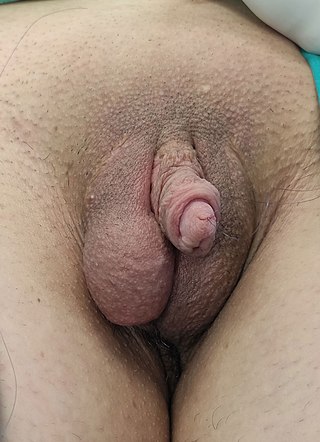Related Research Articles

In amniotes, the clitoris is a female sex organ. In humans, it is the vulva's most erogenous area and generally the primary anatomical source of female sexual pleasure. The clitoris is a complex structure, and its size and sensitivity can vary. The visible portion, the glans, of the clitoris is typically roughly the size and shape of a pea and is estimated to have at least 8,000 nerve endings.
Erectile dysfunction (ED), also referred to as impotence, is a form of sexual dysfunction in males characterized by the persistent or recurring inability to achieve or maintain a penile erection with sufficient rigidity and duration for satisfactory sexual activity. It is the most common sexual problem in males and can cause psychological distress due to its impact on self-image and sexual relationships.

Priapism is a condition in which a penis remains erect for hours in the absence of stimulation or after stimulation has ended. There are three types: ischemic (low-flow), nonischemic (high-flow), and recurrent ischemic (intermittent). Most cases are ischemic. Ischemic priapism is generally painful while nonischemic priapism is not. In ischemic priapism, most of the penis is hard; however, the glans penis is not. In nonischemic priapism, the entire penis is only somewhat hard. Very rarely, clitoral priapism occurs in women.

Benign prostatic hyperplasia (BPH), also called prostate enlargement, is a noncancerous increase in size of the prostate gland. Symptoms may include frequent urination, trouble starting to urinate, weak stream, inability to urinate, or loss of bladder control. Complications can include urinary tract infections, bladder stones, and chronic kidney problems.

In female humans and other mammals, the clitoral hood is a fold of skin that surrounds and protects the glans of the clitoris; it also covers the external clitoral shaft, develops as part of the labia minora and is homologous with the foreskin in the male reproductive system. The clitoral hood is composed of mucocutaneous tissues; these tissues are between the mucous membrane and the skin, and they may have immunological importance because they may be a point of entry of mucosal vaccines.

Penis enlargement, or male enhancement, is any technique aimed to increase the size of a human penis. Some methods aim to increase total length, others the shaft's girth, and yet others the glans size. Techniques include surgery, supplements, ointments, patches, and physical methods like pumping, jelqing, and traction.

An androgen is any natural or synthetic steroid hormone that regulates the development and maintenance of male characteristics in vertebrates by binding to androgen receptors. This includes the embryological development of the primary male sex organs, and the development of male secondary sex characteristics at puberty. Androgens are synthesized in the testes, the ovaries, and the adrenal glands.
Phalloplasty is the construction or reconstruction of a penis or the artificial modification of the penis by surgery. The term is also occasionally used to refer to penis enlargement.

Dihydrotestosterone is an endogenous androgen sex steroid and hormone primarily involved in the growth and repair of the prostate and the penis, as well as the production of sebum and body hair composition.

Metoidioplasty, metaoidioplasty, or metaidoioplasty is a female-to-male gender-affirming surgery.

Virilization or masculinization is the biological development of adult male characteristics in young males or females. Most of the changes of virilization are produced by androgens.
Tumescence is the quality or state of being tumescent or swollen. Tumescence usually refers to the normal engorgement with blood of the erectile tissues, marking sexual excitation, and possible readiness for sexual activity. The tumescent sexual organ in males is the penis and in females is the clitoris and other parts of the genitalia like the vestibular bulbs. Arteries in the penis dilate to increase blood volume.

Clitoromegaly is an abnormal enlargement of the clitoris that is mostly congenital; it is otherwise acquired through deliberately induced clitoral enlargement e.g. body modification by use of anabolic steroids, including testosterone. It can happen as part of a gender transition. It is not the same as normal enlargement of the clitoris seen during sexual arousal.

Finasteride, sold under the brand names Proscar and Propecia among others, is a medication used to treat pattern hair loss and benign prostatic hyperplasia (BPH) in men. It can also be used to treat excessive hair growth in women. It is usually taken orally but there are topical formulations for patients with hair loss, designed to minimize systemic exposure by acting specifically on hair follicles.
Nocturnal penile tumescence (NPT) is a spontaneous erection of the penis during sleep or when waking up. Along with nocturnal clitoral tumescence, it is also known as sleep-related erection. Men without physiological erectile dysfunction or severe depression experience nocturnal penile tumescence, usually three to five times during a period of sleep, typically during rapid eye movement sleep. Nocturnal penile tumescence is believed to contribute to penile health.
Masculinizing hormone therapy, also known as transmasculine hormone therapy or female-to-male hormone therapy, is a form of hormone therapy and gender affirming therapy which is used to change the secondary sexual characteristics of transgender people from feminine or androgynous to masculine. It is a common type of transgender hormone therapy, and is predominantly used to treat transgender men and other transmasculine individuals who were assigned female at birth. Some intersex people also receive this form of therapy, either starting in childhood to confirm the assigned sex or later if the assignment proves to be incorrect.

A micropenis is an unusually small penis. A common criterion is a dorsal penile length of at least 2.5 standard deviations smaller than the mean human penis size. A micropenis is stretched penile length equal to or less than 1.9 cm in term infants, and 9.3 cm in adults. The condition is usually recognized shortly after birth. The term is most often used medically when the rest of the penis, scrotum, and perineum are without ambiguity, such as hypospadias. A microphallus describes a medical term where other sections of genitallia are different, such as hypospadias or cryptorchidism. Micropenis incidence is about 1.5 in 10,000 male newborns in North America.

Clitoral erection is a physiological phenomenon where the clitoris becomes enlarged and firm.

The mechanics of human sexuality or mechanics of sex, or more formally the biomechanics of human sexuality, is the study of the mechanics related to human sexual activity. Examples of topics include the biomechanical study of the strength of vaginal tissues and the biomechanics of male erectile function. The mechanics of sex under limit circumstances, such as sexual activity at zero-gravity in outer space, are also being studied.
The clitoris is a female sex organ present in mammals, ostriches and other amniotes.
References
- 1 2 Horejsí J. (1997). "Acquired clitoral enlargement. Diagnosis and treatment". Ann N Y Acad Sci. 816 (1): 369–372. Bibcode:1997NYASA.816..369H. doi:10.1111/j.1749-6632.1997.tb52163.x. PMID 9238289. S2CID 85705035.
- ↑ Atilla Şenaylı; Etlik Ankara (December 2011). "Controversies on clitoroplasty". Therapeutic Advances in Urology. 3 (6): 273–277. doi:10.1177/1756287211428165. PMC 3229251 . PMID 22164197.
- ↑ S.V. Perovic; M.L. Djordjevic (December 2003). "Metoidioplasty: a variant of phalloplasty in female transsexuals". BJUI . 92 (9): 981–985. doi:10.1111/j.1464-410X.2003.04524.x. PMID 14632860. S2CID 11836091.
- ↑ Meyer, Walter J.; Webb, Alice; Stuart, Charles A.; Finkelstein, Jordan W.; Lawrence, Barbara; Walker, Paul A. (April 1986). "Physical and hormonal evaluation of transsexual patients: A longitudinal study". Archives of Sexual Behavior . 15 (2): 121–138. doi:10.1007/BF01542220. PMID 3013122. S2CID 42786642.
- ↑ Copcu E, Aktas A, Sivrioglu N, Copcu O, Oztan Y (2004). "Idiopathic isolated clitoromegaly: A report of two cases". Reprod Health. 1 (1): 4. doi: 10.1186/1742-4755-1-4 . PMC 523860 . PMID 15461813.
- ↑ Choi, SK; SW Han; DH Kim; B de Lignieres (Aug 1993). "Transdermal dihydrotestosterone therapy and its effects on patients with microphallus". Journal of Urology. 150 (2 Pt 2): 657–660. doi:10.1016/s0022-5347(17)35576-3. PMID 8326617.
- ↑ Shannon Larratt (January 22, 2008). "Saline Clitoral Inflation". BME: Tattoo, Piercing and Body Modification News. Archived from the original on 2012-11-29. Retrieved 2016-12-24.